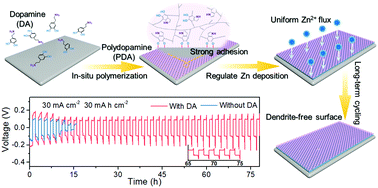Bio-inspired design of an in situ multifunctional polymeric solid–electrolyte interphase for Zn metal anode cycling at 30 mA cm−2 and 30 mA h cm−2†
Abstract
A solid–electrolyte interphase (SEI) is highly desirable to restrain Zn dendrite growth and side reactions between a Zn anode and water in rechargeable aqueous zinc-ion batteries (RAZBs), but remains a challenge. Here, inspired by the bio-adhesion principle, a stable SEI of polydopamine is constructed successfully on a Zn anode via an in situ electrochemical polymerization process of a dopamine additive. This in situ polymeric SEI offers multifunctional features with abundant functional groups and outstanding hydrophilicity for regulating Zn nucleation to achieve dendrite-free Zn deposition, high Zn-ion conductivity for fast Zn2+ transport, and strong adhesion capability for blocking interfacial side reactions. Consequently, the Zn electrodes exhibited high reversibility with 99.5% coulombic efficiency and outstanding stability, even at ultrahigh current density and areal capacity (30 mA cm−2 and 30 mA h cm−2). Moreover, a prolonged lifespan can be attained for the Zn/V2O5 full cell in a lean electrolyte (9 μL mA h−1) and with a low capacity ratio of the negative electrode to the positive electrode (∼2). This work provides inspiration for the design of SEI layers in aqueous battery chemistry and promotes the practical application of RAZBs.



 Please wait while we load your content...
Please wait while we load your content...